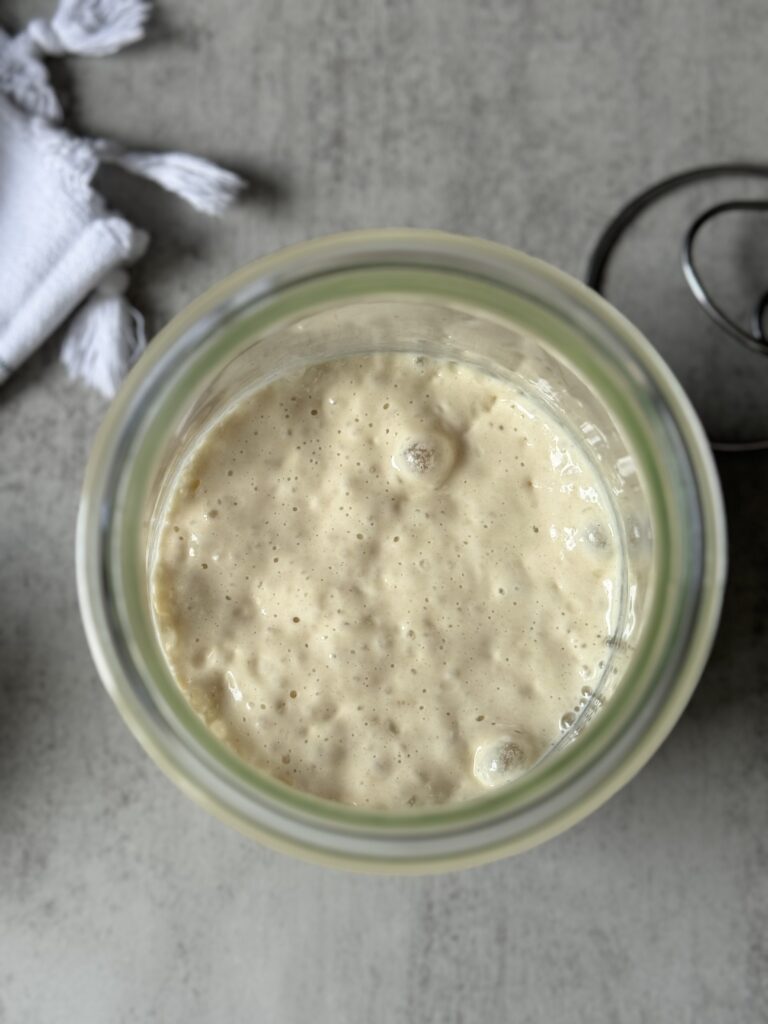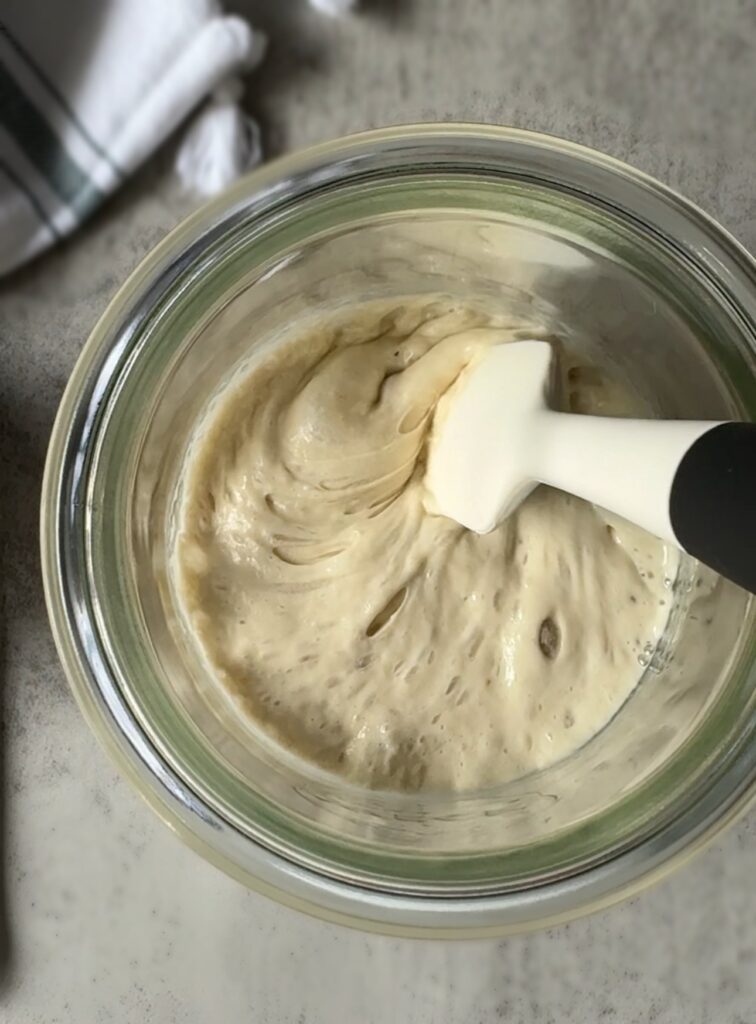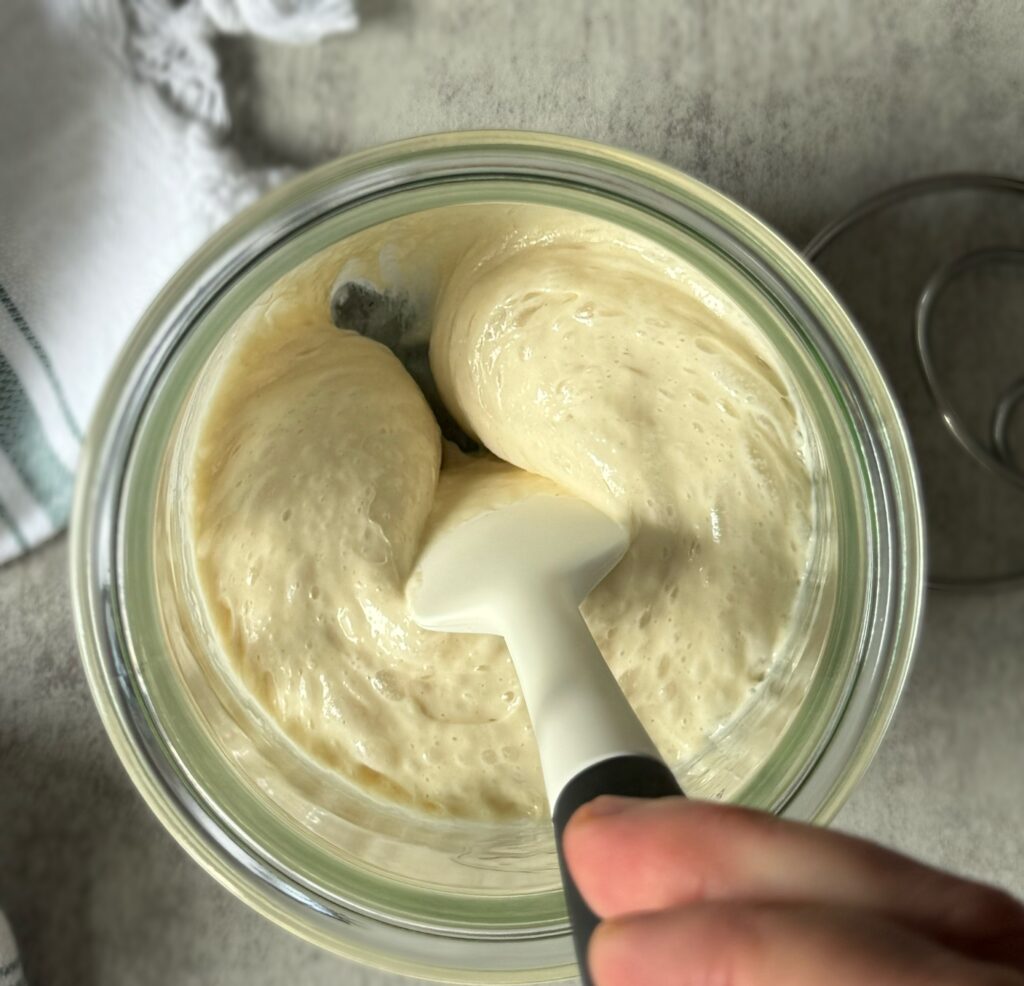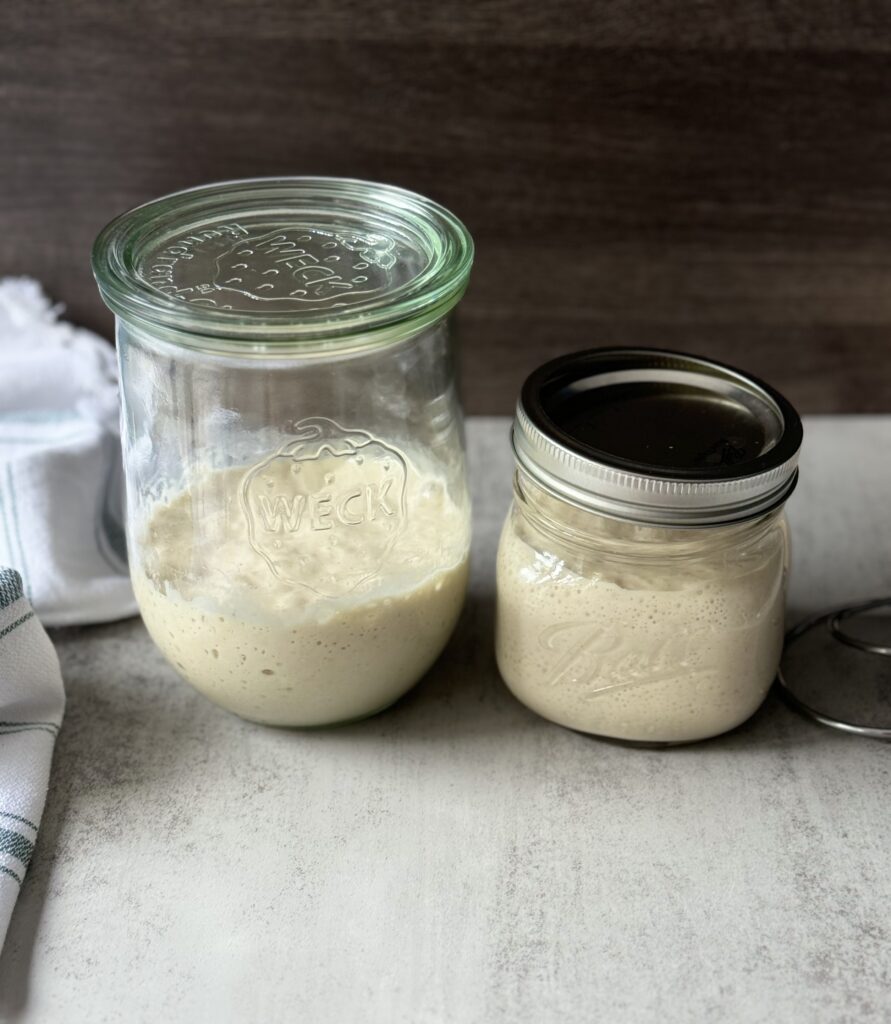Troubleshooting sourdough starters. You’ve made your sourdough starter, but it’s not as lively as you’d like. Or perhaps you want to better understand how to care for it. If you’re aiming for an active, healthy starter and aren’t sure where to begin, this troubleshooting guide has all the answers you need!

Check out my How to Make Sourdough Starter recipe if you want to create your own sourdough starter!
- What is a sourdough starter?
- Troubleshooting sourdough starters: Before we dive in
- Troubleshooting your sourdough starter: FAQ’s
- Patience
- More FAQ’s
- How should I store my sourdough starter?
- What does it mean when a sourdough starter is at its “peak?”
- Why does my starter rise and then fall?
- What is the dark, smelly liquid on my sourdough starter?
- What should my starter smell like?
- In what circumstances should I throw my starter away?
- If I don’t feed my sourdough starter will it die?
- Final thoughts
What is a sourdough starter?
Behind every good loaf of sourdough bread is a strong sourdough starter. It is the key component to achieving quality bread.
Simply put, a sourdough starter is a live culture of flour and water, used as a natural leavening agent in sourdough baking.
It contains wild yeast and lactic acid bacteria, which ferment the dough, giving it a unique flavor and texture. By regularly maintaining and feeding the starter, bakers can use it to make various bread and baked goods rise without the need for commercial yeast.
Although sourdough starters have simple ingredients, they require an ongoing and consistent relationship.
This begins with understanding. That is why I put together this article, in hopes of helping in your sourdough journey.
Troubleshooting sourdough starters: Before we dive in
This article focuses on troubleshooting a 100% hydration sourdough starter, fed equal parts of water and flour.
If you are interested in learning about a sweet stiff starter, check out my Sweet Stiff Sourdough Starter article.
Take your time reading this article, as it contains a wealth of detailed information. It might be helpful to print it out, read through it a few times, and make notes or highlight key points for easier reference.

Troubleshooting your sourdough starter: FAQ’s
Why is my starter not rising?
Sourdough starters are not a one-size-fits-all. Because they are living cultures, they each have their own unique personalities and needs. It is important to get to know your sourdough starter through observation.
Below I’ll list some key components that help achieve a healthy, active starter.
Temperature
Ensure your starter is kept in a warm environment, ideally between 75-85°F (24-29°C). Colder temperatures can slow down yeast activity.
A few ways to achieve a warmer environment:
- Store your sourdough starter in a warm kitchen cabinet.
- Keep it in the microwave or oven next to a hot bowl of water.
- Wrap the jar in a warm towel.
- Use a proofing box.
- Lastly, feed it with warm water (around 80-90 degrees F)
Overtime as your sourdough starter matures, it will rise well even at room temperature. Continue to monitor its activity, as it ages it may not need such a warm environment.
A sourdough starter typically matures around 10-14 days, however, this can vary. For me, my starter became strong nearly a year into my baking journey. Don’t give up.
Feed often
Make sure you are feeding your starter with the correct ratio of flour and water, typically every 12-24 hours, to keep it active and healthy.
This type of feeding schedule does not need to be ongoing. However, it is beneficial to feed it frequently at the beginning of the journey to build strength.
Or if you keep your starter in the refrigerator (like I do). It may need to sit at room temperature for a few days and get some daily feedings for a boost.
Sample feeding ratios
I recommend feeding your sourdough starter between 1;3;3-1;5;5 ratios.
I typically feed my starter at a 1;5;5 ratio. This means I keep around 20 grams of sourdough starter and discard the rest. I then feed it 5x itself of water and flour, so 100 grams of water and 100 grams of flour.
Different ratio examples:
1;3;3: 20 grams sourdough starter, 60 grams water, 60 grams flour.
1;4;4: 20 grams sourdough starter, 80 grams water, 80 grams flour.
Never feed a sourdough starter too early. I’ve learned that feeding your starter before it’s finished its current food can weaken it. Stick between a 12-24 hour feeding schedule.
Stirring: Stir your starter once or twice a day between feedings to aerate it, which helps activate the yeast.
Use the right flour
Ingredients matter! I recommend using an unbleached, organic all-purpose or bread flour for feeds.
Additionally, whole grain flours like whole wheat or rye can boost activity due to their higher nutrient content.
Every baker uses their preferred flour. I use King Arthur all-purpose and bread flour. I have also used Central Milling.
Water quality: Use filtered or bottled water. Tap water can contain chlorine or other chemicals and these can inhibit yeast growth.
Consistency: Ensure the consistency of your starter is like a thick pancake batter. Too much water can make it too runny and slow down the rising process.

Discard Regularly
Remove a portion of your starter before feeding to keep the acidity in check and ensure a healthy, thriving culture.
What is sourdough discard? Sourdough discard is the portion of the sourdough starter that is removed before feeding the remaining starter with fresh flour and water. This process is essential to maintain a healthy balance of yeast and bacteria in the starter.
The discard can accumulate over time, but it doesn’t have to go to waste. It can be used in various recipes like pancakes, sweet bread, muffins, crackers, and other baked goods.
How do you store sourdough discard? I store it in an airtight mason jar in the refrigerator for 1-2 weeks.

Patience
Patience is arguably the most important component when it comes to sourdough in general.
“My sourdough starter used to be bubbly & active, now there is little to no activity.”
This is normal! When first creating a sourdough starter it can take weeks for you to see consistent activity. This is where patience comes into play.
Sourdough starters need consistent and regular feedings. No need to give up or start the process over. Eventually, you will see results.
Continually observe and adjust. Pay attention to how your starter responds and adjust the feeding schedule or flour type as needed based on its activity level.
More FAQ’s
How should I store my sourdough starter?
Use a clean, non-reactive container (glass, plastic, or ceramic) with a loose-fitting lid to allow gases to escape.
The jars I use are linked here.
What does it mean when a sourdough starter is at its “peak?”
When a sourdough starter is at its “peak,” it means that it has reached its maximum level of fermentation and activity after a feeding. This is the optimal time to use the starter for baking. Here are the key indicators that your starter is at its peak:
- Volume Increase: The starter has doubled or tripled in volume.
- Bubbles: The surface and throughout the starter are full of bubbles, indicating active fermentation.
- Texture: It has a light, airy texture and a sponge-like consistency.
- Smell: The aroma is pleasantly tangy and slightly sweet.
How long does it take for a starter to reach its peak? This can depend on the temperature and what ratio you fed your starter. It can range from anywhere to 4-12 hours. Feeding it at a 1;5;5 ratio at room temperature will typically take 12 hours.
The fastest way to have your starter ready is feeding it a 1;1;1 ratio. It will peak around 4 hours at 70-75 degrees F.
Why does my starter rise and then fall?
A sourdough starter rises and then falls due to the activity of the wild yeast and bacteria present in the mixture. Here’s a brief explanation:
- Fermentation: Wild yeast and bacteria in the starter feed on the sugars in the flour, producing carbon dioxide (CO₂) gas and organic acids.
- Rise: The CO₂ gas gets trapped in the gluten network of the flour, causing the starter to rise and become bubbly and airy.
- Peak Activity: The starter reaches its peak activity when the yeast and bacteria have consumed most of the available sugars, leading to maximum gas production and volume.
- Fall: As the food supply diminishes and the acids accumulate, the yeast and bacteria slow down, and the gluten network can no longer hold the gas, causing the starter to deflate and fall.
This cycle is a natural part of maintaining a sourdough starter and indicates the balance between yeast activity and food availability.
What is the dark, smelly liquid on my sourdough starter?
The dark, smelly liquid that sometimes forms on top of a sourdough starter is called “hooch.” Hooch is a byproduct of the fermentation process and is essentially alcohol produced by the yeast. It’s a sign that your starter is hungry and needs to be fed.
What to do with hooch:
- Stir it in: You can stir the hooch back into the starter before feeding it. This is a common practice and won’t harm the starter.
- Pour it off: If you prefer, you can pour off the hooch before feeding. This can help reduce the sourness of the starter.
How to prevent hooch: feed it more frequently.
What should my starter smell like?
Healthy smells: sweet, fresh, yeasty, with an overall pleasant aroma. It may have a mildly acidic smell when hungry.
Unhealthy smells:
- Alcoholic or Nail Polish Remover: This indicates that the starter is producing hooch and is very hungry. It needs to be fed more frequently.
- Strong Acetic (Vinegar-like): While a mild vinegar smell is normal, a strong, overpowering acetic smell can mean the starter needs more frequent feedings or better temperature control.
- Rotten or Moldy: This could indicate contamination, and it’s best to discard the starter and start fresh.
In what circumstances should I throw my starter away?
- Mold: If your sourdough starter begins to grow mold on it, its unsalvgable at this point and needs to be thrown away. Environmental factors and simply neglecting the sourdough starter can cause this.
- Contamination: if any sort of foreign object lands into the sourdough starter, it may become contaminated and need to be thrown out. This can include insects, chemicals, etc.
If I don’t feed my sourdough starter will it die?
In most cases your sourdough starter will not die. Sourdough starters are quite resilient and can bounce back with a little TLC.
I’ve taken long vacations where my sourdough starter has hung out in the fridge for a few weeks. When I was available and ready to feed it, it bounced right back after a few feeds and room temperature resting.
Final thoughts
I hope this article provided you with a wealth of information without overwhelming you!
As mentioned earlier, printing out this article and taking notes on it for future reference may be helpful.
Remember, the key takeaways are patience and consistency with your sourdough starter. With dedication, your starter will thrive.
A strong, mature starter will adapt to your specific environment over time. Eventually, it won’t require daily feedings, allowing for more flexibility in your baking schedule.
Keep observing and learning about your sourdough starter. With ongoing patience and commitment, your starter will flourish.
Feel free to leave any comments or questions below. I’ll update this article periodically, as there are endless scenarios to discuss.
Happy baking!


Leave a Comment & Rate the Recipe